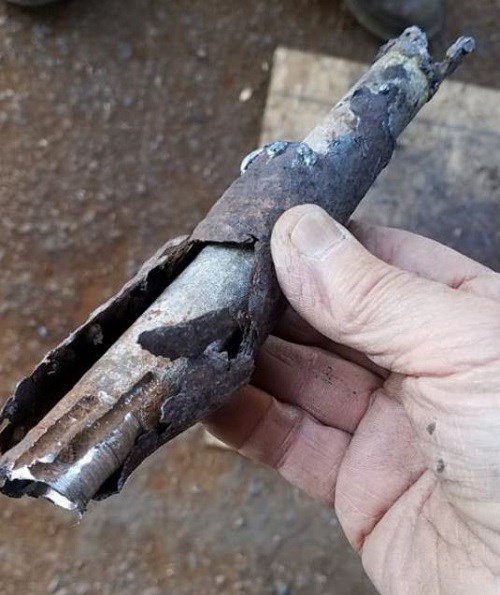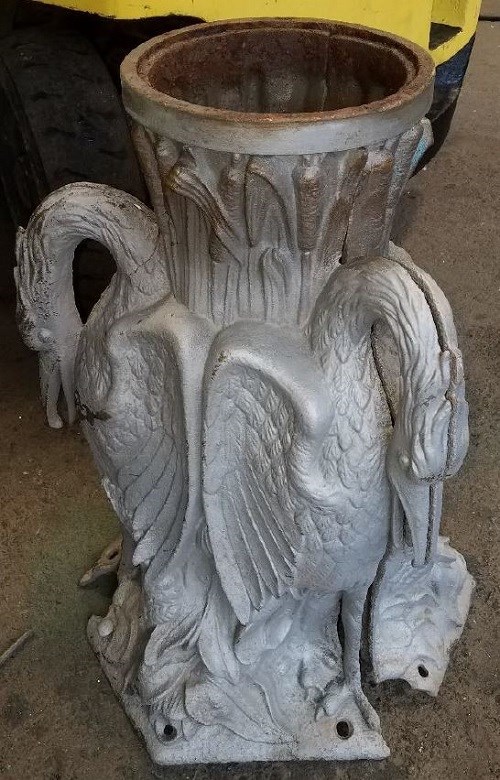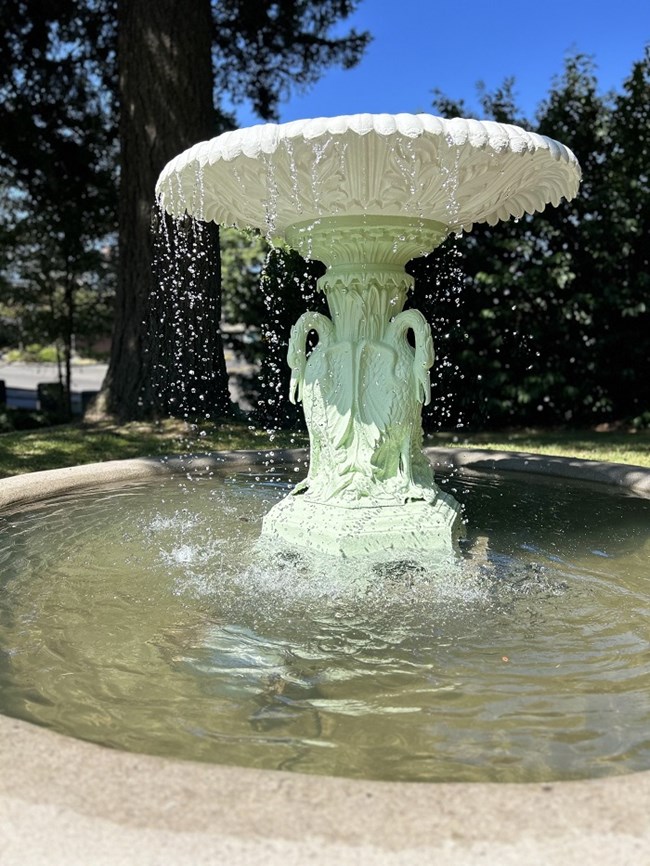Last updated: August 18, 2023
Article
Conservation of the Historic Fountain at the McLoughlin House

Dean and Associates Conservation Services

Fort Vancouver NHS Archives
The fountain was gifted to the local community in 1911 by the Oregon City Woman's Club as a memorial to Dr. John Mcloughlin. McLoughlin was the Chief Factor of Fort Vancouver, and aided many American immigrants arriving over the Oregon Trail before retiring to Oregon City, Oregon. The Oregon City Woman's Club assisted the McLoughlin Memorial Association and other grassroots organizations in saving the McLoughlin home from demolition in 1909.
The fountain consists of four parts: a concrete-lined pool, a concrete base, a cast iron pedestal decorated with standing birds, and a water basin, which was once topped by the figure of a child with a parasol (missing for many decades). Fountains like this one could be ordered in parts from foundries or catalogs. Buyers could select mass-produced pieces to create a combination they liked.
The original quality of the fountain resulted in some structural flaws over time, but nonetheless the fountain was a landmark in the Oregon City park in which the McLoughlin House is located. Its presence shows us how early 20th century women's groups worked to create community spaces in remembrance of historical events and people.

Dean and Associates Conservation Services
Getting Started
Over a century of constant use resulted in corrosion, structural instability, cracking, and biological growth. Past efforts had been made to restore the fountain. In 1978, a partial restoration effort was made that stabilized the base but misaligned the base pieces. In 1994, the fountain was sandblasted and painted teal green and given a new recirculating pump system.
Conservation work began on the fountain in 2019 to keep it preserved into the future. This project to restore the historic McLoughlin House fountain was funded by the National Park Service and the Oregon City Woman's Club. Conservator Claire Dean of Dean and Associates Conservation Services oversaw the research and treatment of the fountain, while Jim Schmidt, an artist and metal fabricator for Art & Design Works, LLC, carried out the deinstallation and metal restoration.

Dean and Associates Conservation Services

Dean and Associates Conservation Services
Conserving History
After historic research on the fountain was complete, the fountain was deinstalled and removed from its Oregon City park in September 2020. The fountain and base were sandblasted to remove the teal paint and corrosion. The pieces of the fountain were coated with an acrylic primer. This coating will protect the cleaned fountain from corrosion.
Rather than welding the fountain to its base, as had been done in the past, new stainless steel bolts were installed to the base feet to prepare for its reattachment to the fountain base. New steel plates were bolted into the interior of the fountain pedestal to increase its structural strength and bring broken pieces together. A stainless steel central water pipe was made and secured inside the fountain.
Finally, the fountain was painted with two coats of water-based, catalyzed epoxy paint. Examination of historic photos and other similar fountains from the time period revealed that the fountain was probably originally two-toned, with a light green and off-white color scheme.

NPS Photo / S. Weber
The Fountain Today
The conserved fountain pieces were delivered to Fort Vancouver National Historic Site in late 2020. Through the COVID-19 pandemic, the fountain remained safely in storage at the national historic site. Finally, in the summer of 2023 the fountain was reinstalled and celebrated in a special ceremony hosted by the National Park Service and the McLoughlin Memorial Association. Back in position, the fountain was surrounded by a newly reformed concrete basin and equipped with a new pump system and piping.
Conservation work aims to extend the life of historic objects so that future generations can appreciate and gain insight into the past. Today, the fountain serves as a reminder of the significance of the McLoughlin family to the history of the Northwest and to the story of Oregon City, Oregon. The women who worked to bring this fountain to their community in honor of its most famous resident are remembered in this peaceful, shady park around the McLoughlin House.

NPS Photo / P. Hale
